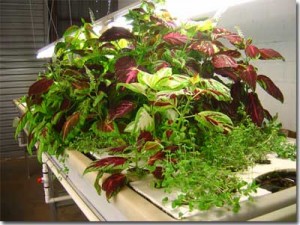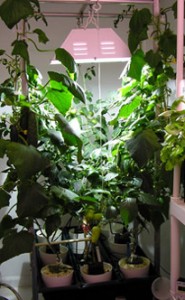The use of grow lights also allows you to control the length of the days (daylight) the plants receive if desired, this can result in faster more vigorous growth. Using artificial light also allows them cut back the length of the days, in order to trigger fruiting/flowering in some plants. The use of artificial “supplemental lighting” in greenhouses that generally use natural light is also useful during the winter months, in order to extend the daylight hours, by using them before the sun comes up, and in the evening when it begins to go down.
Deciding what artificial lights best for your plants can be complicated. It can also be very confusing as well, especially with the 100’s of thousands of grow bulbs on the market, and all the different types of lighting that are available. You even have your specific plants lighting needs to consider. Even how much heat your lighting system  produces, and venting that heat away can be a problem. Not to mention the energy costs of all of it. There are also four other variables that will further determine the overall light output and effectiveness of your lighting systems. Lamp wattage, mounting height, spacing, and the age of the bulbs (bulbs will loose some of there intensity (Lumens) as they are used and get older. The higher the wattage the higher the lamp output (Lumens), also the closer the light is to the plants the more lumens reach the foliage.
produces, and venting that heat away can be a problem. Not to mention the energy costs of all of it. There are also four other variables that will further determine the overall light output and effectiveness of your lighting systems. Lamp wattage, mounting height, spacing, and the age of the bulbs (bulbs will loose some of there intensity (Lumens) as they are used and get older. The higher the wattage the higher the lamp output (Lumens), also the closer the light is to the plants the more lumens reach the foliage.
Choosing what type of artificial light to go with
When choosing an artificial light, it’s important to take into consideration the type of light that’s best for the particular plants you want to grow first. The spectrum’s of light, as well as the lights intensity (Lumens). Plants like lettuce don’t need the same light that pepper plants do. Lettuce plants generally do better in a low intensity light than they would in a high intensity light, and pepper plants like high intensity light. So it’s important to find out the lighting requirements of your plants first, or grow plants that are best suited to the lighting you already have. Here are the basic differences between types of lighting.
Metal Halide Bulbs (MH)
Metal Halide bulbs are probably the most widely used type of artificial lighting, and are recommend most by many gardeners. The reason is, it has excellent spectral distribution. Metal halide bulbs emulate bright summer sunlight and contain all the energy peaks at wavelengths of the visible spectrum. This means to plants good quality simulated sunlight and photosynthesis. Metal halide grow lights also have good lumen maintenance that translates into a long life expectancy (it’s decline in lumen output is very gradual). Metal Halide is about the best bulb technology that’s available for achieving the highest level of plant and flower growth. They allow the flexibility of multi-crop, multi-season indoor gardening.
High Pressure Sodium Bulbs (HPS)
High pressure sodium bulbs are the only bulbs that can really compare with metal halide bulbs. They have good spectral distribution, but cannot compare to halide bulbs in the blue end of the light spectrum, and metal halide bulbs cant compete with Sodium bulbs in the red end of the spectrum. Sodium bulbs are much higher in the yellow and red ends of the spectrum. This is the type of light that fruiting and flowering plants like best. But because HPS bulbs focus more on the red spectrum, some plants grown with only sodium lights can become elongated and leggy.  Sodium lights do on the other hand, stimulate flower and fruiting more effectively than metal halide alone. So their an important light source that’s best used in conjunction with metal halide, either in addition to, or cycled together.
Sodium lights do on the other hand, stimulate flower and fruiting more effectively than metal halide alone. So their an important light source that’s best used in conjunction with metal halide, either in addition to, or cycled together.
LED Grow Lights
Plants seem respond well to LED lights similar to fluorescent’ lights. They generally result in a tight inter-nodal growth, and short stocky, strong plants. The plants do look a little different, the leaves can tend to curl down, but are usually thicker and a more healthy shade of green. Vegetative growth tends to be a little slower compared to MH and HPS lights, but seem to be healthy and progress normally. Fruiting and flowering is also slightly slower but healthy. One LED UFO will come very close to the best results you could achieve with a 400 watt HPS and it uses only 1/4 of the electricity, plus it doesn’t generate any heat. But LED’s are NOT the best choice for big plants however, that’s because they loose light intensity quickly the farther away the foliage is from the light source.
High Output Fluorescent’s
T5 high output fluorescent tubes produce very little heat which lets you position them closer to your plants in order to raise light intensity to the foliage. High output fluorescent’s are great for seedlings and cloning. T5 high output fluorescent’s put out 5000 lumens per tube and have solid state electronic ballasts that do not emit heat, noise or vibration. Although they cant compare to the light output of MH and HPS bulbs, and are not the best choice for tall plants, because they also loose light intensity quickly the farther away the foliage is.
Compact Fluorescent lights (CFL’s)
CFL’s are a lot like the high output florescent, but work best in small spaces as they do not produce much heat or use much electricity. For fruiting or flowering plants, the 2700K warm bulbs are best. For plants taller than a foot, regular fluorescent tubes can be supplemented on the sides of the plants to increase light intensity. When using CFL’s, you should remember to use the actual wattage (NOT their wattage equivalents) when calculating how many watts you need for your plants.
